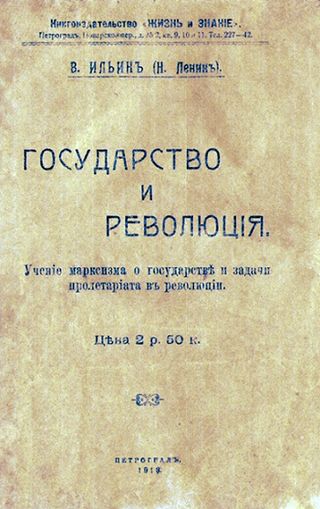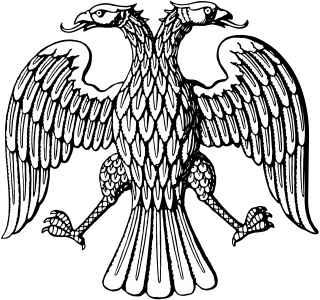
The Bolsheviks, led by Vladimir Lenin, were a far-left faction of the Marxist Russian Social Democratic Labour Party (RSDLP) which split with the Mensheviks at the Second Party Congress in 1903. The Bolshevik party, formally established in 1912, seized power in Russia in the October Revolution of 1917, and was later renamed the Russian Communist Party, All-Union Communist Party, and Communist Party of the Soviet Union. The party's ideology, based on Leninist and later Marxist–Leninist principles, is known as Bolshevism.

Leninism is a political ideology developed by Russian Marxist revolutionary Vladimir Lenin that proposes the establishment of the dictatorship of the proletariat led by a revolutionary vanguard party as the political prelude to the establishment of communism. Lenin's ideological contributions to the Marxist ideology relate to his theories on the party, imperialism, the state, and revolution. The function of the Leninist vanguard party is to provide the working classes with the political consciousness and revolutionary leadership necessary to depose capitalism.

The October Revolution, also known as the Great October Socialist Revolution, October coup, Bolshevik coup, or Bolshevik revolution, was a revolution in Russia led by the Bolshevik Party of Vladimir Lenin that was a key moment in the larger Russian Revolution of 1917–1923. It was the second revolutionary change of government in Russia in 1917. It took place through an insurrection in Petrograd on 7 November 1917 [O.S. 25 October]. It was the precipitating event of the Russian Civil War. The initial stage of the October Revolution which involved the assault on Petrograd occurred largely without any human casualties.

The Russian Revolution was a period of political and social change in Russia, starting in 1917. This period saw Russia abolish its monarchy and adopt a socialist form of government following two successive revolutions and a civil war. It can also be seen as the precursor for the other revolutions that occurred in the aftermath of World War I, such as the German Revolution of 1918–1919. The Russian Revolution was one of the key events of the 20th century.

The State and the Revolution: The Marxist Doctrine of the State and the Tasks of the Proletariat in the Revolution is a book written by Vladimir Lenin and published in 1917 which describes his views on the role of the state in society, the necessity of proletarian revolution, and the theoretic inadequacies of social democracy in achieving revolution to establish the dictatorship of the proletariat.
"Dual power" refers to the coexistence of two Russian governments as a result of the February Revolution: the Soviets, particularly the Petrograd Soviet, and the Russian Provisional Government. The term was first used by the communist Bolshevik leader Vladimir Lenin (1870–1924) in the Pravda article titled "The Dual Power".

The Red Terror was a campaign of political repression and executions in Soviet Russia carried out by the Bolsheviks, chiefly through the Cheka, the Bolshevik secret police. It officially started in early September 1918 and lasted until 1922. Arising after assassination attempts on Vladimir Lenin along with the successful assassinations of Petrograd Cheka leader Moisei Uritsky and party editor V. Volodarsky in alleged retaliation for Bolshevik mass repressions, the Red Terror was modeled on the Reign of Terror of the French Revolution, and sought to eliminate political dissent, opposition, and any other threat to Bolshevik power.
Sorokin, or Sorokina, is a common Russian surname, derived from the Russian word soroka. Those bearing it include the following:
The first significant attempt to implement communism on a large scale occurred in Russia following the February Revolution of 1917, which resulted in the abdication of Tsar Nicholas II. The Bolshevik Party, led by Vladimir Lenin, capitalized on the discontent with the Provisional government and successfully seized power in the October Revolution of the same year. Lenin's government began to transform Russian society through policies such as land redistribution, nationalization of industry, and withdrawal from World War I. After Lenin's death in 1924, Joseph Stalin's rise to power brought about rapid industrialization, forced collectivization, and widespread political repression, which solidified the Soviet Union's status as a major world power but at a tremendous human cost.

The All-Russian Congress of Soviets evolved from 1917 to become the supreme governing body of the Russian Soviet Federative Socialist Republic from 1918 until 1936, effectively. The 1918 Constitution of the Russian SFSR mandated that Congress shall convene at least twice a year, with the duties of defining the principles of the Soviet Constitution and ratifying peace treaties. The October Revolution ousted the provisional government of 1917, making the Congress of Soviets the sole, and supreme governing body. This Congress was not the same as the Congress of Soviets of the Soviet Union which governed the whole Soviet Union after its creation in 1922.

Georgi Valentinovich Plekhanov was a Russian revolutionary, philosopher and Marxist theorist. Known as the "father of Russian Marxism", Plekhanov was a highly influential figure among Russian radicals, including Vladimir Lenin.

Ivan Lukich Sorokin Russian: Ива́н Луки́ч Соро́кин; 4 December 1884 – 3 November 1918) was a Russian military leader and participant in the Russo-Japanese War, World War I, and the Russian Civil War. He was Commander-in-Chief of the Red Army of the North Caucasus and Commander of the 11th Red Army.

The All Russian Constituent Assembly was a constituent assembly convened in Russia after the February Revolution of 1917. It met for 13 hours, from 4 p.m. to 5 a.m., 18–19 January [O.S. 5–6 January] 1918, whereupon it was dissolved by the Bolshevik-led All-Russian Central Executive Committee, proclaiming the Third All-Russian Congress of Soviets the new governing body of Russia.

The Party of Socialist-Revolutionaries, also known as the Socialist Revolutionary Party, was a major political party in the late Russian Empire, during both phases of the Russian Revolution, and in early Soviet Russia.

The Mensheviks were a faction of the Marxist Russian Social Democratic Labour Party (RSDLP) which split with Vladimir Lenin's Bolshevik faction at the Second Party Congress in 1903. The Mensheviks were led by Julius Martov and Pavel Axelrod.

Pitirim Alexandrovich Sorokin was a Russian American sociologist and political activist, who contributed to the social cycle theory.
Revolutionary socialism is a political philosophy, doctrine, and tradition within socialism that stresses the idea that a social revolution is necessary to bring about structural changes in society. More specifically, it is the view that revolution is a necessary precondition for transitioning from a capitalist to a socialist mode of production. Revolution is not necessarily defined as a violent insurrection; it is defined as a seizure of political power by mass movements of the working class so that the state is directly controlled or abolished by the working class as opposed to the capitalist class and its interests.

Foundations of Leninism was a 1924 collection made by Joseph Stalin that consisted of nine lectures he delivered at Sverdlov University that year. It was published by the Soviet newspaper, Pravda.

The Second All-Russian Congress of Soviets of Workers' and Soldiers' Deputies was held on November 7–9, 1917, in Smolny, Petrograd. It was convened under the pressure of the Bolsheviks on the All-Russian Central Executive Committee of the First Congress of Soviets of Workers' and Soldiers' Deputies.
The Political parties of Russia in 1917 were the aggregate of the main political parties and organizations that existed in Russia in 1917. Immediately after the February Revolution, the defeat of the right–wing monarchist parties and political groups takes place, the struggle between the socialist parties and liberals on the one hand, and the struggle between moderate socialists and radicals.


















